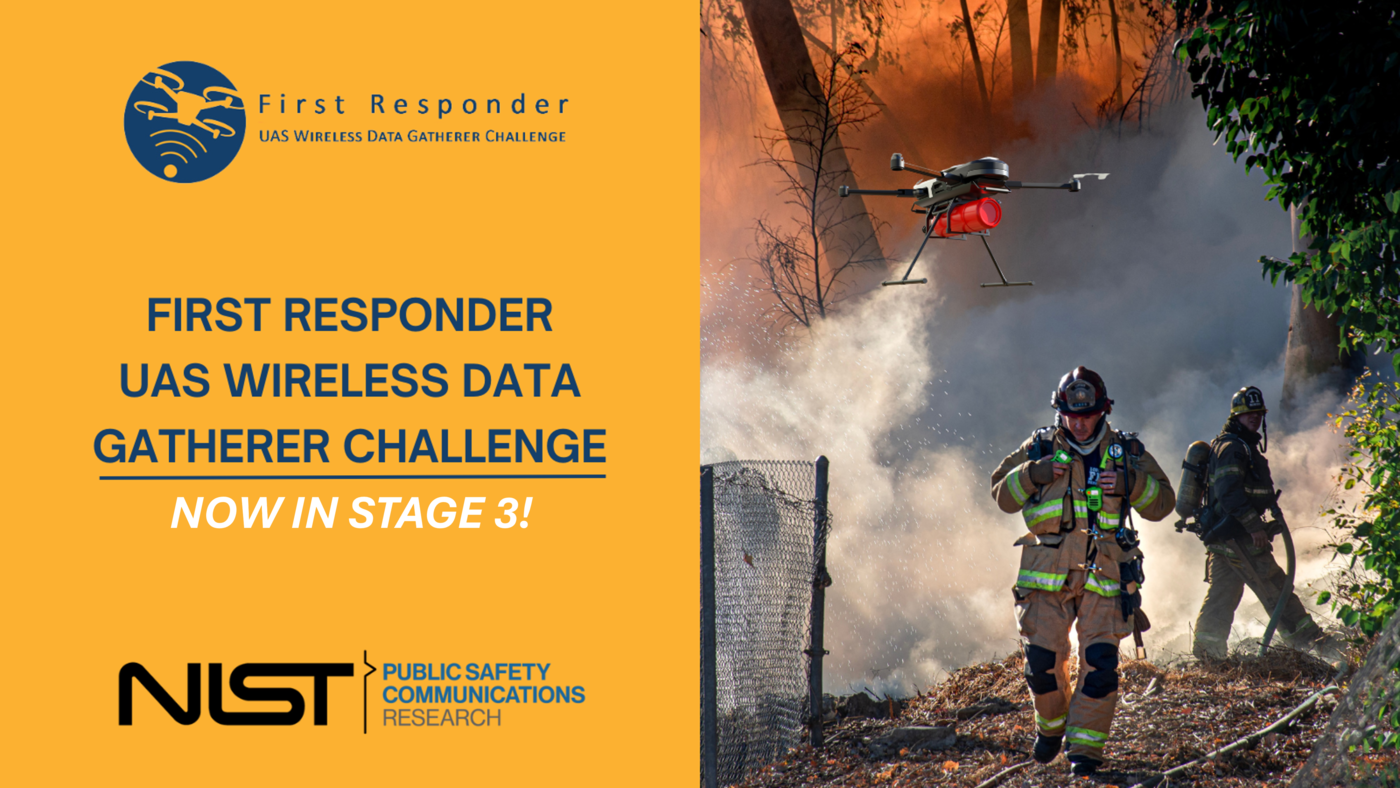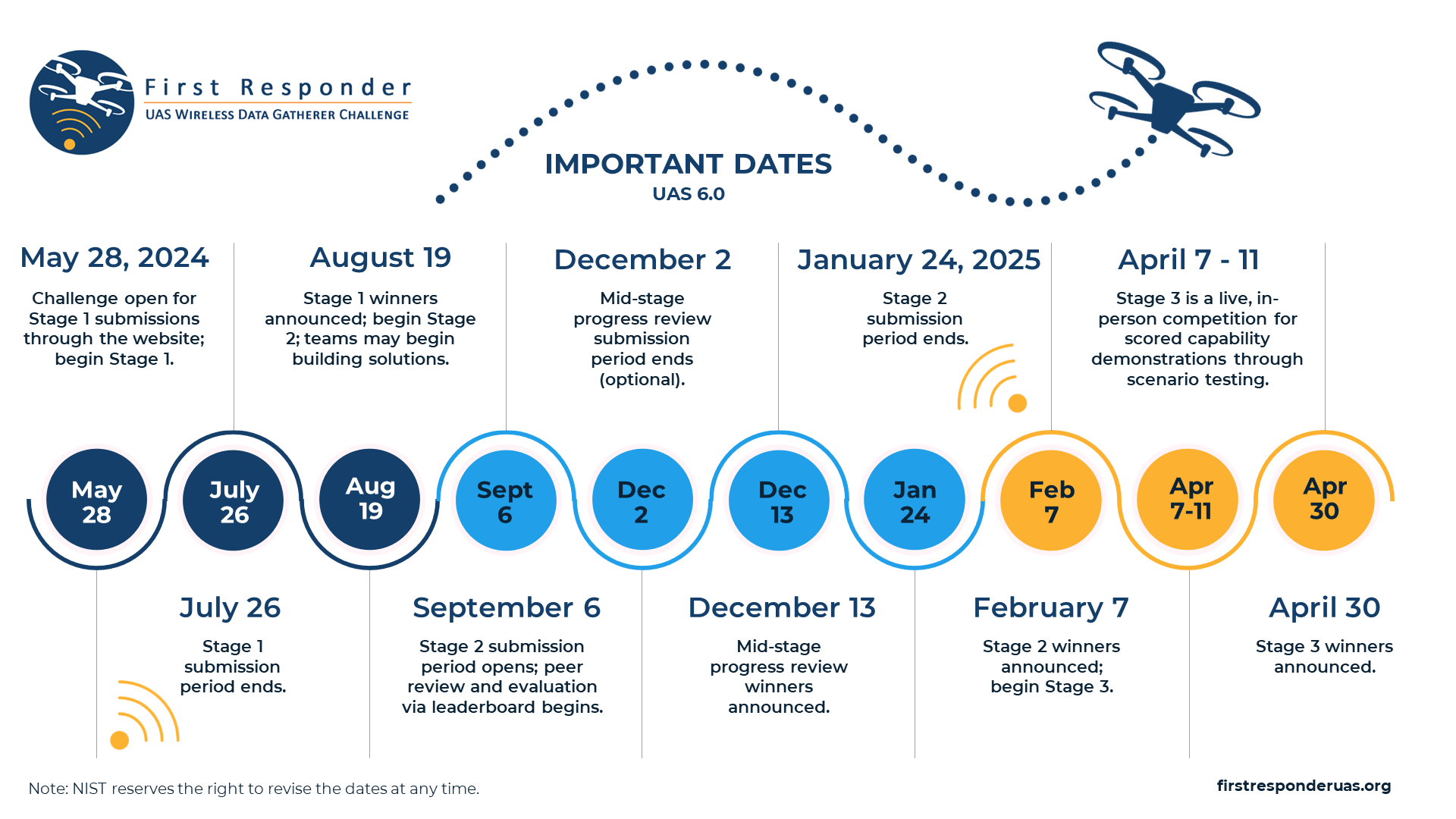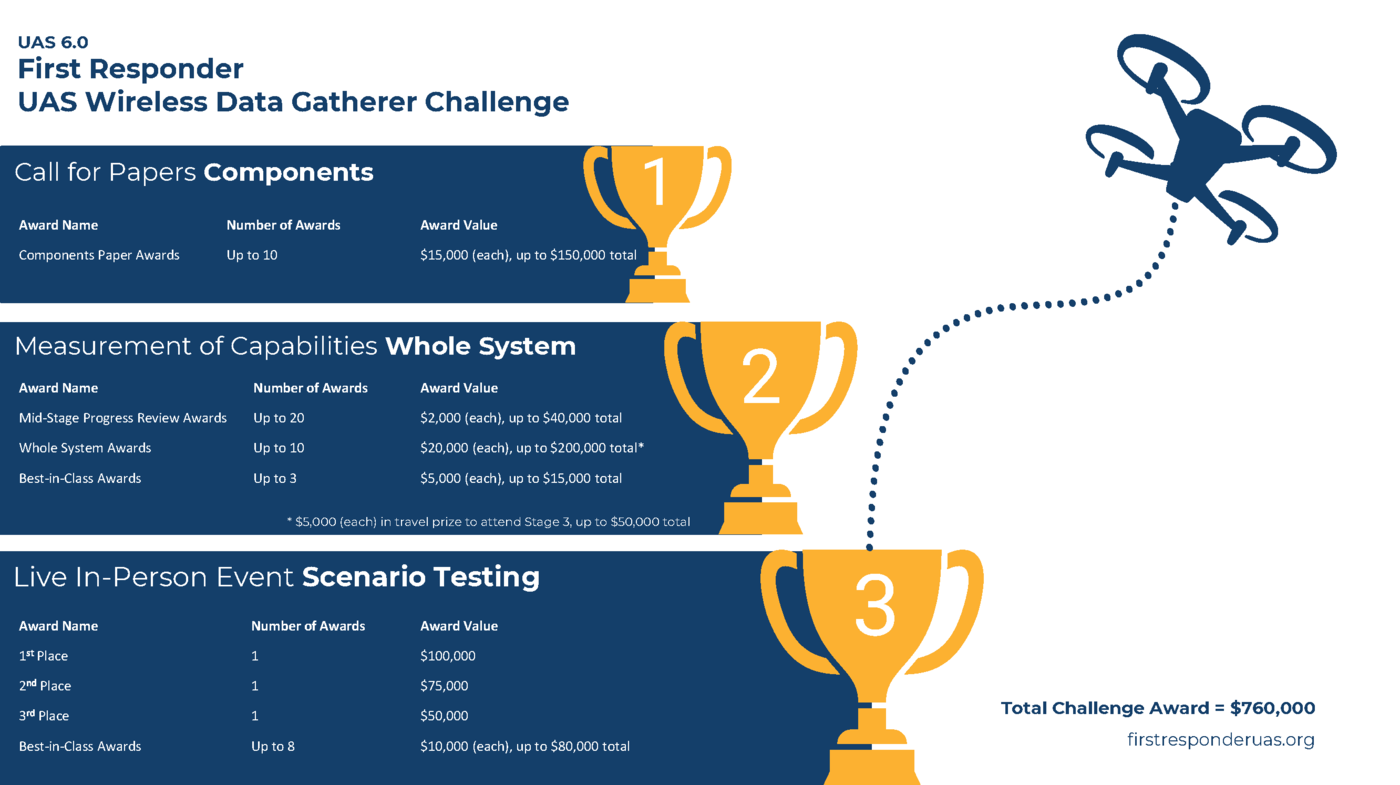2024 First Responder UAS Wireless Data Gatherer Challenge
About the First Responder Uncrewed Aircraft System (UAS) Wireless Data Gatherer Challenge (UAS 6.0)
Compete for $760K in total prizes plus a chance to demonstrate your prototype at a live competition
NIST PSCR hosted the three-stage First Responder UAS Wireless Data Gatherer Challenge (UAS 6.0) with prize awards of up to $760,000. UAS 6.0 sought innovators with applicable expertise across and beyond the UAS ecosystem. For public safety and the greater good, contestants could contribute invaluable knowledge and ingenuity in artificial intelligence (AI), radio communications and mapping, Internet of Things (IoT), cybersecurity, and more. Challenge results supported the public safety community and its partners to improve real-time situational awareness and save lives while operating in potentially dangerous radio-complex outdoor environments without fixed communications infrastructure or satellite communications.

Background
There are a wide variety of situations where public safety personnel need information from ground sensors (aka “Target Objects of Interest”), where there is little to no existing communications infrastructure, insufficient power to access satellites, and challenging radio environments for low bandwidth or high latency. Examples of such ground sensors include IoT sensors dropped ahead of a fire in mountainous terrain or the cell phones near survivors of a natural disaster. There is great potential for first responders to be able to leverage aerial vehicles to collect as much up-to-date information as possible from these ground sensors, including data transmitted over radio and visual imagery which is conveyed to a mission commander and kept up to date throughout a response. Such information can help the mission commander to plan the early and ongoing phases of the response, detect changes as early as possible, and improve overall safety. By reducing the number of first responders approaching dangerous situations, situational awareness is enhanced through sensing or continuous communications.
Goals & Objectives
The challenge objective was to foster the development, and integration into UAS, of new technologies that will drive capabilities for public safety missions using next generation, intelligent, connected UAS, and with appropriate risk management, particularly with regard to cybersecurity and AI. Specifically, the challenge goal was to design, test, and build a UAS that can autonomously survey and inspect designated ground sensors within specific geographic limits, with the capability for emergency intervention and sustained operation.
The challenge comprised three stages, with Stages 1 and 2 building toward the ultimate goal in Stage 3 of contestants fielding systems consisting of a single, battery-powered, sub-55 lb. UAS, equipped with hardware, software, and a ground control station that can perform the following high-level tasks:
- Allow for geographic bounds and controls that can terminate the mission in the event of unexpected dangerous behavior.
- Perform a radio survey of the environment, locating and inspecting ground sensors that it finds in a complex environment.
- Periodically communicate with and inspect the ground sensors for a predefined mission duration (expected to be well over one battery life for a multirotor helicopter).
Successful solutions should also be easy to operate, durable, and affordable. PSCR expected contestants to demonstrate their understanding of how solutions for UAS in public safety need to manage cybersecurity and AI risks, and their entries should appropriately manage risk by design.
Contestants with promising component technologies, regardless of whether currently a part of the UAS ecosystem, were encouraged to enter in Stage 1: Call for Papers – Components. Contestants with the most outstanding Stage 1 submissions received prizes for assisting them in participating in Stage 2: Measurement of Capabilities – Whole System. Stage 2: Measurement of Capabilities – Whole System was also open to the same eligible contestants as Stage 1 was not a prerequisite for entry to Stage 2. In addition to the broad range of contestants encouraged to enter Stage 1, those contestants with narrower technological competencies or UAS experience were also encouraged to enter Stage 2 because of the offered Best-in-Class awards. Contestants with the best Stage 2 submissions won an invitation to participate in Stage 3: Live In-Person Event — Scenario Testing.
Please refer to the graphics below for specific key dates and prize amounts.


Challenge winners by stage
Stage 3: Live In-Person Event – Scenario Testing
| Award | Winner | Amount |
|---|---|---|
| 1st Place | United First Responder Technology Coalition (UFRTC) | $100,000 |
| 2nd Place | Team Engineering Dynamics | $75,000 |
| 3rd Place | Team Flyt | $50,000 |
| Best Single Scenario Score - Positive Aircraft Control | United First Responder Technology Coalition (UFRTC) | $10,000 |
| Best Single Scenario Score - Endurance | Team Engineering Dynamics | $10,000 |
| Best Single Scenario Score - Collision Avoidance | Team Flyt | $10,000 |
| Best Single Scenario Score - Survey Acuity | United First Responder Technology Coalition (UFRTC) | $10,000 |
| Best Affordable Solution | Team Engineering Dynamics | $10,000 |
| Best Highly Portable Solution | Team Engineering Dynamics | $10,000 |
| First Responders' Choice | Team Engineering Dynamics | $10,000 |
| First Responders' Choice | $5,000/team (tie) |
Stage 2: Measurement of Capabilities – Whole System
The following Whole System Award winner received $25,000 in prize awards and invitations to compete in Stage 3:
- Team NavigateIO (also won a $5,000 Best-in-Class Award for Inspection and Survey Acuity)
- United First Responder Technology Coalition (also won a $5,000 Best-in-Class Award for Radio)
- Team Engineering Dynamics (also won a $5,000 Best-in-Class Award for Endurance)
- Team Flyt
The following Whole System Award finalists received invitations to compete in Stage 3:
- Team TF66
- Team Blackbird Labs
- Team ManTech
The following Mid-Stage Progress Review Award winner received $2,000 in prize awards:
- Team NavigateIO
Stage 1: Call for Papers – Components
The following winners each received $15,000 in prize awards:
- Team Aqvolant
- Team Athena
- Team Autonomous Sky Sentinel
- Team Blackbird Labs
- Team Cognomentum
- Team Engineering Dynamics
- Team Flyt
- Team NavigateIO
- Team TF66
- United First Responder Technology Coalition
Additional Information
The First Responder UAS Wireless Data Gatherer Challenge is being hosted by NIST’s PSCR Division and managed by Ensemble Government Services, LLC, in partnership with Ezassi, Inc. and Indiana University.

